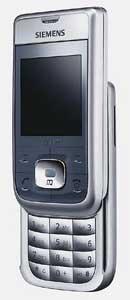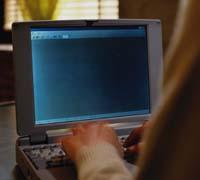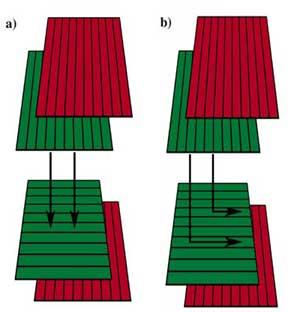Flat TFT screens, latest news

For several years, the only option that has existed on the market for the purchase of computer screen has been: CRT system. This system of screens is known since the usual televisions in the home are CRT and almost 100 years without knowing any other system. CRT means cathodic ray tube, which is due to its functioning. In fact, it moves an electron beam on the screen back and forth, illuminating the selected parts of the screen. The screen contains phosphorus and the electron beam lights up when colliding with phosphorus.
However, for a few years, the use of other types of screens is increasing. These types of screens are technically called LCD, but street people prefer to call themselves flat screen. What tools is the flat screen used in? It was initially used only in calculators and digital clocks, but is currently used on mobile phones, electronic calendars and computer screens. As with conventional televisions, the initial flat screens were of a single color. Later, colored flat screens were invented. Flat color screens with better resolution are TFT type.
Conventional CRT displays
Although CRT displays may be thought to have become obsolete, flat screens still have advantages they do not have. For example, CRT displays have better resolution than flat screens. In addition, this resolution can be modified and each can choose the relationship between screen size and resolution. In addition to better resolution, they have the ability to display a wider range of colors and, if not enough, are significantly cheaper than flat screens.
Given such an advantage, it does not seem that we should have doubts. The CRT screen looks like a good option. However, before flat screens, CRT displays present some drawbacks.
The most remarkable difference is that – regardless of whether they use a different technology – CRT displays are huge when compared to flat screens. This can be a problem when we have little room to work on the table. They also have more consumption. Also, although we mentioned that they have a better resolution, the sharp angles are not represented correctly, so sometimes the image appears on the screen as stained. In addition, there are two problems related to the physical process used to obtain the image.

On the one hand, CRT screens flash. We will realize this when we are watching TV. This ñir-ñir is due to the refresh frequency of the screen. To prevent loss of screen image, screen match is constantly bombarded with electron beam. Although these shocks occur several times in a second, from one bombardment to another the image turns off a little and goes back on with the next bombing. There is the reason for that ñir-ñir.
On the other hand, there is a difference between the actual screen size and the image size we see.
For example, the image we see on a 17-inch screen is about 16.1 inches.
Flat or LCD screens
With flat screens we solve to some extent the problems of CRT screens. If CRTs are larger than flat screens and have higher consumption, just flip the logic argument to list the advantages of flat screens.

Flat screens will be suitable so if we have to work in small space offices, they consume less than CRT screens. Because the technique they use to display the image on screen is different, they do not have the above mentioned ñir-ñir.
In addition, unlike CRT screens, flat screens adequately represent acute angles. This is a remarkable advantage for designers. LCD displays allow you to visualize perfect geometric images. Unlike CRT screens, these images do not suffer losses and occupy the entire screen width. That is, following the example above, the image of a 17-inch screen is 17 inches.
It is something not mentioned above. For example, due to screen components, flat screens remain longer. Conventional CRT displays use phosphorus that does not properly illuminate the screen when it loses its properties. On the other hand, by not using electromagnetic elements, that is, by not using electron beams in the cathode tube back and forth, they do not generate this type of radiation.
If we look for more advantages, we will have to go to the TFT screens that are the latest novelty on flat screens.
The most cutting-edge: TPL

Flat TFT screens have all the above advantages and others that do not have conventional LCD screens. However, to better understand these advantages, it is important to know how flat screens work internally.
Liquid crystal molecules are stored on the screen between two polarized sheets. By applying electrical potentials, these molecules are ordered in one way --which allows the passage of light - or other--without letting go of light. Each crystal is therefore like a shutter of a camera.
Flat TFT screens are characterized by using a transistor to control each liquid crystal or pixel. Consequently, in this pixel the intensity and color of the light is much better controlled. In this way a resolution is obtained in the form of CRT screens. On the simplest TFT displays – for example, calculators or digital clocks – the potential can be applied in each segment independently – turning on or off certain digits of the clock, for example.
However, when the screen is large, this system is not practical, as millions of connections should be made to illuminate each pixel. Instead, pixels are sorted into columns and lines. If the pixels of a given line receive a positive potential and those of a certain negative column, the pixel at the cut-off point is the one that suffers the greatest potential difference and turns on. For better control of this process, as mentioned above, each pixel has its own transistor.
Individual

To be placed in place it must be said that flat screens also have errors. Unlike CRT screens, there are resolution problems on flat screens. Each flat screen originates a different resolution for each type. If you want to change the resolution to another one other than the original one, there is the possibility, but the image loses quality and does not get enough performance to the screen.
Moreover, LCD screens do not reproduce colors as well as CRT screens. Lower color range. That is, flat screens do not reproduce exactly the shades of colors. On the other hand, flat screens cannot be viewed from any angle. If we look correctly, the image looks good, but if we turn the head or look at the screen transversely, it seems that the image disappears from the screen. It is a simple consequence of the arrangement of liquid crystals. Liquid crystal pixels are a network of forward facing cells.
TFT displays use the transistor to control pixels. This can properly control pixel lighting, but it can also cause problems. If the transistor is damaged, the controlling pixel is completely off or on. A black or white dot remains on the screen forever.
Flat screens are also more expensive, because they have the same technology, more expensive. Of course, TFT screens are the most expensive on LCD screens. Once all this is known, everyone will have to see, depending on the cases, the type of screen that suits them.






